
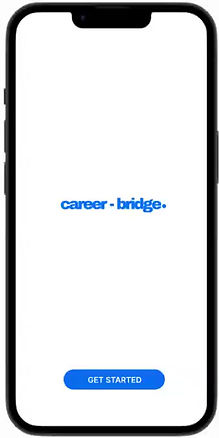
My role
UX Design (Personal Project)
Project Duration
2 weeks, 2022
MAIN TOOL USED
Figma
-Do you know what a foreign accent is? It’s a sign of bravery -
About
background
As a step towards learning Figma, I challenged myself to design the user interface for an app. At first I was not sure what to design, but then, I got inspired by the people that were around me. Let me tell you a little more… During that period of my life, I resided in a hostel for several weeks, and during my stay I had the privilege of forming connections with a circle of individuals who had recently migrated to the UK. As an immigrant myself, and having personally experienced the challenges of navigating a complex foreign legal system and the overwhelming task of finding the right organisations for support, I was inspired to create an app aimed at helping immigrants streamline the process of connecting with organisations that can assist them in finding suitable employment based on their skillset.
understanding the problem (secondary research)
According to the Home Office, over half million people migrate to the UK. These people carry with them a rich tapestry of backgrounds and distinct life situations. However, they are bound together by the shared challenges and obstacles encountered while embarking on the journey of establishing a new life in an unfamiliar land.
Based on ONS, Home Office, and Facebook groups, the biggest challenge for new immigrants are:
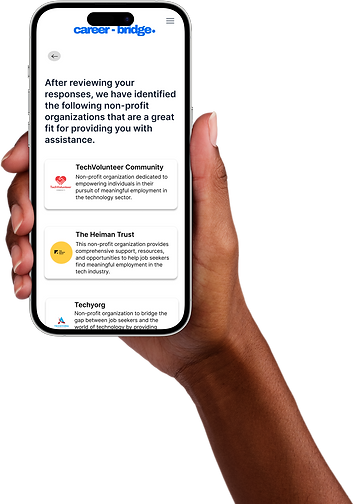
Cultural difference
Housing
Language barrier
Employmeny
Education
Financial adjustments
Healthcare access
Legal procedures
All of these factors, including unfamiliarity with the local job market and the potential non-recognition of qualifications, lead to unemployment or prolonged job search processes. These challenges impact the career progression of new immigrants as they strive to establish themselves in their adopted country, as well as the stability of the economy.
In addition, finding the right and trustworthy support for settling in a new country is not an easy task. Online information may be outdated and unreliable, and connecting with immigration advisers can take a considerable amount of time. Furthermore, their services and resources may not be suitable for everyone.
competitive analysis
Findings from the competitive analysis show that currently in the UK market, there are no apps that connect users to the right non-profit organisations capable of providing career coaching. There are apps that offer similar services but they are aimed at students.

Empathising with users & define the problems
unstructured interview
I interviewed 6 people with the following characteristics:
-
3 people have lived in the UK for less than one year.
-
2 people have lived in the UK for over five years.
-
1 person has lived in the UK for over 20 years.
The aim of the interview was to understand immigrant challenges and attitudes in finding support, as well as finding employment.
I engaged with individuals in a free-flowing conversation, enabling participants to express their thoughts and experiences without predefined questions. I opted for open-ended format interviews due to the complex nature of the topic. I wanted to delve deeply into participants' experiences, emotions, and perceptions.
empathy maps
After each interview, I order the data gathered in empathy maps to enable me to identify valuable insights about the users and facilitate the development of user personas.
Tool used for organising data: Miro
.jpg)
insights

Getting appointments with job centres, non profits, local councils for advice can be challenging due to the waiting time and lack of resources.

Feeling uncertain about whom to seek advice from and which steps to take, leading to frustration in the search for support.

Immigrants find it difficult to navigate a career change, as they are unsure about how to leverage their skills effectively in an unfamiliar job market, adapting to recruitment practices, and identifying appropriate opportunities.

People find it hard and overwhelming to find reliable and trustworthy information as sometimes the information might be too generic and not tailored to their needs and circustamces.

Language barriers can hinder communication when interviewing for jobs, communicating with colleagues, supervisors, and clients, impacting job performance and advancement.

Immigrants may lack professional networks in the new country, making it harder to access job opportunities and mentorship

Unfamiliarity with local salary expectations and negotiation practices can lead to immigrants being underpaid for their skills and experience.

Navigating work visas, residency permits, and legal requirements can be complex and stressful for immigrants.

Immigrants face uncertainty in the process of getting their qualifications accredited in the UK often due to their unfamiliarity with the process or insufficient financial resources to facilitate it.

Immigrants find it challenging re-entering the education system, frequently due to a lack of familiarity with the process - complex legal procedures - lack of financial resources
user personas

problem statement
Luis, a first-generation immigrant who has recently relocated to the UK, is seeking free and reliable guidance and support to work as a nurse, because the online resources available on the matter are misleading and complex to understand.

problem statement
Sofia, a Polish woman who has been living in the UK for 2 years, needs help to pivot her career and enter the tech job market because the existing online resources are misleading, making her feel overwhelmed and confused about the necessary steps to take.
HMWs (how might we)
I used HMWs to explore how to solve potential problems.
How might we deepen our understanding of the user to match them with the ideal organisation that suits their needs?
How might we ensure the app remains accessible to all users, regardless of their tech literacy and language barriers?
How might we make it easier for the user to connect with non profit organisations, local councils, support groups, and job centres?
Ideate
crazy 8
To help me brainstorm alone, I undertook the Crazy 8 exercise, dedicating only one minute to each square. This technique helped me to generate ideas quickly within a concise timeframe.
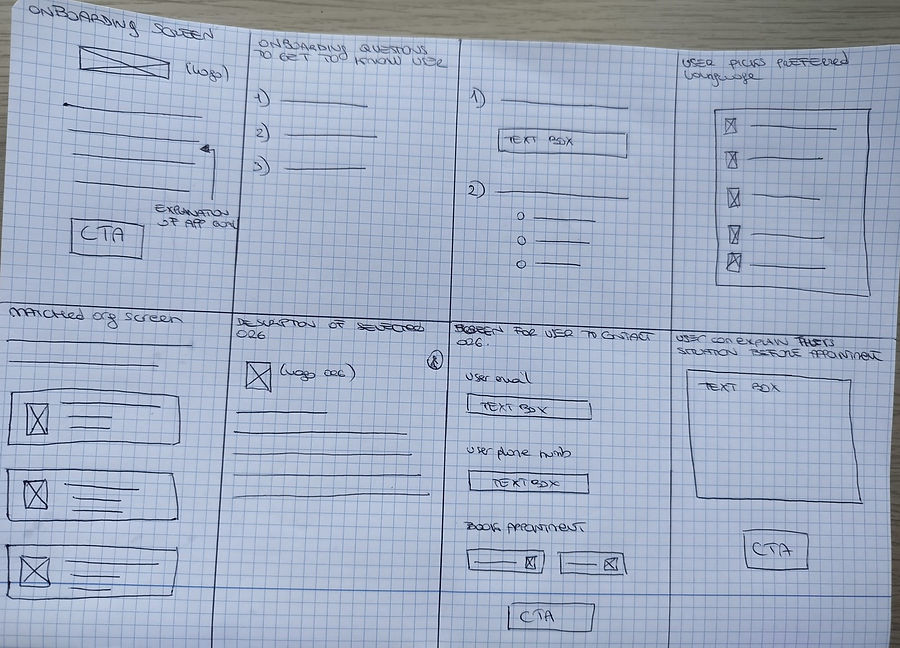
Prototype & Testing
wireframes
Following the Crazy 8 exercise, I concluded that the most effective approach to understanding user circumstances is to create a short questionnaire. The questions encompass a wide range of topics, including the user's background, educational history, migratory status, and desired career path.
By analysing the user's responses, we can then match them with suitable organisations. Users will have the opportunity to explore a variety of matched non-profits, local councils, job centres, agencies, groups and programs . They can explore their missions, services, read inspirational stories, and schedule appointments. Additionally, to streamline the process, they can also upload necessary documents prior to their appointments.
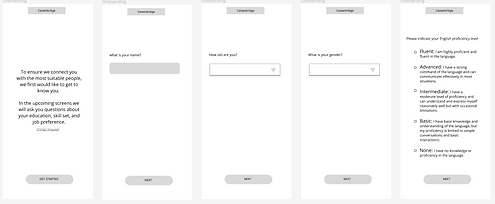


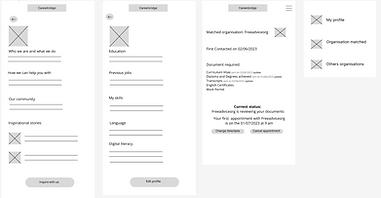
user interviews
In order to understand if I was on the right track, I asked 5 of my peers, who are also immigrants, to try out the lo-fi prototype.
The aims of the interviews were:
-
Determine whether the questions asked in the questionnaire were appropriate or if I needed to include additional questions;
-
Gather insights about the terminology used throughout the app;
-
Identify any other features users would like to see in an app like this one.

affinity diagram
During the interviews I organised the data collected on Miro; and subsequently, I created an affinity diagram, aiming to spot prevalent themes and valuable insights.
.jpg)
mockups
The insights gathered from the interviews indicated that the questions posed were relevant. However, there was a need to enhance the terminology used for CTA buttons and refine the navigation. Drawing from these valuable feedback, I proceeded to design the mockups.
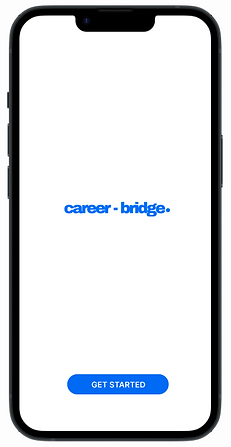



users can choose their preferred language starting from the second onboarding screen.



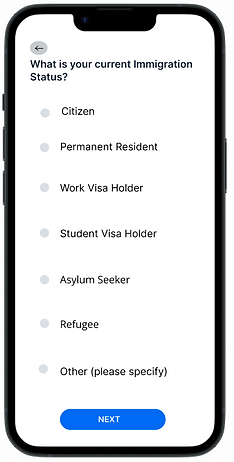
The majority of screens feature just one question, contributing to a clean and uncluttered design that facilitates focused attention.


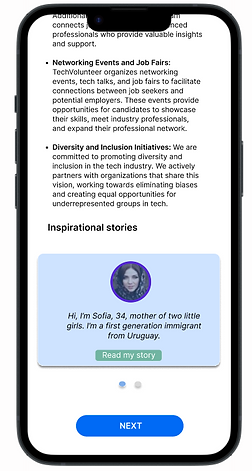
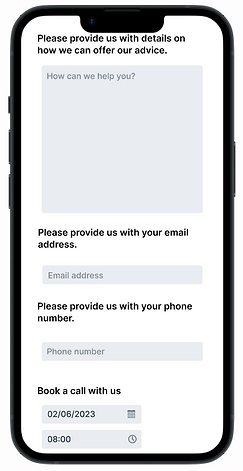
Users are presented with a list of matched organizations, but if they are unsatisfied with their choices they can explore others organisations available. Once they have selected their chosen organisation and have read about the organization's missions, services, inspirational stories, and scheduled appointments, they are able to provide detailed information about their circumstances.
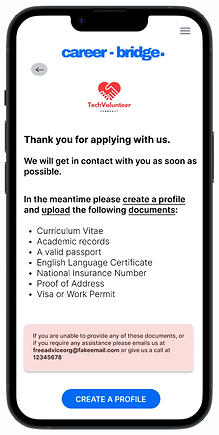


Once the user has provided their details and set an appointment, they are able to create a profile and upload the required documents. I kept the design simple and included only essential information to avoid overloading the user.
hi-fi prototype


Final thoughts
how successful is my design?
Because this is a fictional project, I cannot evaluate how successful my design is, except by conducting usability testing with people to gauge their experience with my hi-fi prototype.
If this was a real app, I would measure the success of this design by adopting the following metrics:
Usability metrics:
-
SUS
-
Task error rate
-
Navigation path
User engagement metrics:
-
Download rate
-
Click-Through Rate (CTR)
-
Conversion Rate